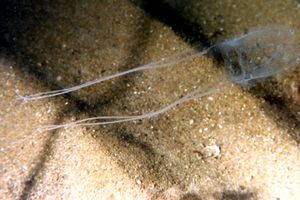Carybdea marsupialis
| Carybdea marsupialis | ||||||||||||
|---|---|---|---|---|---|---|---|---|---|---|---|---|

Carybdea marsupialis |
||||||||||||
| Systematics | ||||||||||||
|
||||||||||||
| Scientific name | ||||||||||||
| Carybdea marsupialis | ||||||||||||
| Linnaeus , 1758 |
The Carybdea marsupialis counts as a box jellyfish within the family Carybdeidae to the genus Carybdea . The species was scientifically described in 1758 by the Swedish scientist Carl von Linné .
features
The milky white and almost transparent umbrella of Carybdea marsupialis reaches a height of up to 40 mm with a width of up to 30 mm, larger specimens can rarely appear. The medusa has numerous, small and yellowish nettle warts distributed over the entire umbrella. The umbrella is typically cube-shaped, with a total of four tentacles , one per corner, which can be up to one meter in length. Three types of nettle cells were found on the tentacles : heterotrichic microbasic euryteles, flat holotric isorhizas, and rounded holotric isorhizas. The pedalia and the umbrella are armed with holotric isorhizas and an unidentified type of small, teardrop-shaped nettle cell. The gastric cirrus contains heterotrichic microbasic euryteles.
Way of life
Carybdea marsupialis lives predatory on zooplankton , often in shallower waters. It can move at a speed of between 3 and 6 meters per minute. Like most species of its genus, Carybdea marsupialis also has comparatively highly developed lens eyes, with the help of which the medusa can probably orient itself and even recognize obstacles like an oar and avoid them. This species can occur in smaller schools.
toxicology
The toxin from Carybdea marsupialis has, in particular, cytotoxic (tissue-destroying) properties. Contact with the nettle cells leads to an extremely painful reaction combined with burning pain that lasts for hours. The reddening of the skin can last for one to two days, and pronounced urticaria ( hives ) occurs regularly . Despite the violent reaction, intoxication (poisoning) by Carybdea marsupialis is not as dangerous as by some related species (e.g. Chironex fleckeri ) and is mostly limited to local symptoms. The treatment is carried out by rubbing in diluted wine vinegar and cooling the affected skin area; a doctor should be consulted under certain circumstances.
Rottini et al. (1995) demonstrated a heat-labile protein without phospholipase activity with a molecular mass of 102-107 kDa, which is characterized by hemolytic activity. Erythrocytes from sheep were sensitive in the experiment, but not those from humans or rabbits . The effect is presumably based on the formation of pores in the biomembrane of the erythrocytes.
Occurrence
Carybdea marsupialis is the only representative of the box jellyfish in the Mediterranean, here it was detected in the coastal regions of the Riviera , the Italian Adriatic Sea and North Africa . It is also common in the tropical Atlantic , South Pacific , Indian Ocean, and around the Philippines .
swell
Individual evidence
- ↑ C. Di Camillo, M. Bo, S. Puce, S. Tazioli and G. Bavestrello: The cnidome of Carybdea marsupialis (Cnidaria: Cubomedusae) from the Adriatic Sea. Journal of the Marine Biological Association of the United Kingdom, 86 (4): 705-709, Cambridge 2006 doi : 10.1017 / S0025315406013609
- ^ GO Mackie: Coelenterate Ecology and Behavior . Springer Science & Business Media, December 31, 1976, ISBN 978-0-306-30991-5 , p. 237.
- ↑ Rottini et a .: Purification and properties of a cytolytic toxin in venom of the jellyfish Carybdea marsupialis , Toxicon 33 (3), pages 315-326 (March 1995).
- ↑ QB Kazmia1 and R. Sultana: Carybdea marsupialis (Cnidaria: Cubomedusae) -observed for the first time in Gwadar Bay waters (Arabian Sea). Marine Biodiversity Records, 1: e80, Cambridge University Press 2008 doi : 10.1017 / S1755267207008251
literature
- Frei, Herzer & Schmidt: Poisonous and dangerous marine animals , Müller Rüschlikon. ISBN 9783275016013 .

